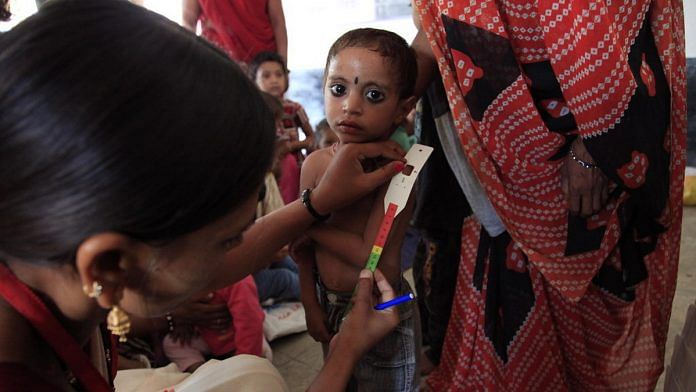
New Delhi: The first phase of the National Family Health Survey 5 (NFHS 5), released last week, found a massive increase in malnutrition among children in the 22 surveyed states and Union Territories.
In episode 642 of ‘Cut The Clutter’, ThePrint’s editor-in-chief Shekhar Gupta analysed the data from the survey to highlight some worrying trends that have emerged since 2015.
“For the first time since ’98/’99, India has reversed the trend [on child nutrition],” said Gupta
Nutrition, he noted, is judged on three factors. The first is stunting, which refers to a condition when a child below 5 years is substantially below the ideal height at that age.
The second parameter is wasting — when the child is tall enough but doesn’t have sufficient weight.
“On both these indicators i.e. from 1998-1999 to 2015-2016, India was doing better…in fact, it improved by 10 percentage points that is substantial…[So] this is the first time after two decades that India has reversed this virtuous trend,” Gupta said.
Best- and worst-performing states
Highlighting the “surprising” findings from the survey, Gupta noted that in Goa, which is the richest state in India, the level of stunting has gone up from 20.1 per cent to 25.8 per cent — an increase of 5 percentage points or 25 per cent.
This trend was also seen in the welfare state of Kerala where stunting has gone up from 19.7 per cent to 23.4 per cent. In Telangana, too, the increase was from 28 per cent to 33.1 per cent.
Meanwhile, Tripura was “the worst-performing state” where the figure went up from 24.3 per cent to 32.3 per cent. This trend was also seen in other states like Gujarat and Maharashtra. Sikkim was the only Northeastern state to show an improvement and had the lowest rate of stunting at 22.3 per cent.
“But the biggest surprise on the upside…was the state of Bihar,” said Gupta.
Even though the state still reported a stunting rate of 42.9 per cent, it is a big improvement from 48.3 per cent. According to Gupta, this was one of the reasons why Nitish Kumar keeps coming to power in the state.
Meanwhile, wasting has also become worse in several states. “The range varies from Kerala, where it increased by 0.1 per cent…And on the other end of the spectrum there is Ladakh with a tiny population [where wasting has gone up by] 8.2 per cent,” he said.
Among the states where this has improved is Karnataka, where wasting has come down by 6.6 per cent.
The third indicator — children who are underweight vis-a-vis their age and height — improved on Bihar from 43.9 per cent to 41 per cent.
Kerala, however, showed deterioration from 16.1 per cent to 19.7 per cent. In Telangana, as well, this increased from 26.6 per cent to 28.9 per cent while the Northeastern states remain at the bottom.
Of declining incomes & a ‘triple whammy’
Gupta said that although people would criticise the Modi government over its Swachh Bharat Mission and the National Nutrition Mission, data shows that sanitation in India has improved.
Dwelling on what went wrong in terms of nutrition, he quoted Purnima Menon of International Food Policy Research Institute.
“She says that this is a three-legged stool on which child nutrition sits. Two are sanitation and government support for nutrition, but the third more important leg is family income. And if the family income declines this becomes unbalanced,” he said.
Data from the last five years have shown that India’s economic condition has deteriorated, which became steeper since demonetisation. As a result, there has been an overall decline in family incomes.
The survey also revealed that the proportion of overweight children has increased. In Gujarat, it has gone up from 1.9 per cent to 3.9 per cent. In Himachal Pradesh, it has gone up from 2.6 per cent to 5.7 per cent while in Mizoram, it has gone up from 3.8 per cent to 10 per cent.
On this, Gupta said, “There is an overdoing of carbohydrates but a lack of iron, minerals, micronutrients that is leading to this malnutrition epidemic. Also, there is a junk food epidemic.”
The contradiction in the data spells a “triple whammy” for India and that is very worrisome, he added.
Watch the latest episode of CTC here:
Subscribe to our channels on YouTube & Telegram
Why news media is in crisis & How you can fix it
India needs free, fair, non-hyphenated and questioning journalism even more as it faces multiple crises.
But the news media is in a crisis of its own. There have been brutal layoffs and pay-cuts. The best of journalism is shrinking, yielding to crude prime-time spectacle.
ThePrint has the finest young reporters, columnists and editors working for it. Sustaining journalism of this quality needs smart and thinking people like you to pay for it. Whether you live in India or overseas, you can do it here.